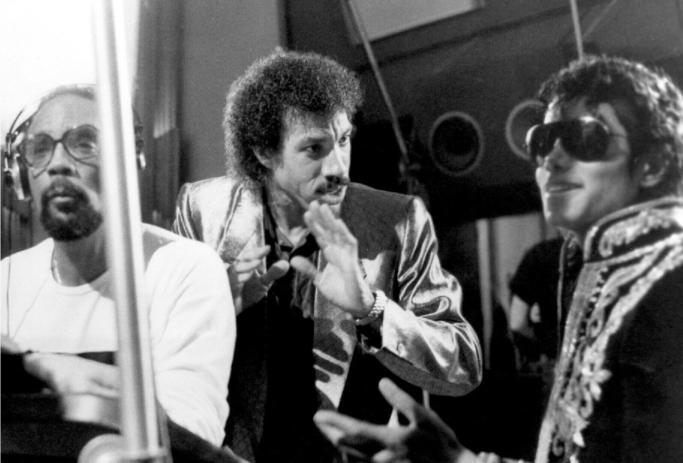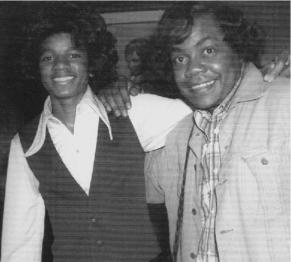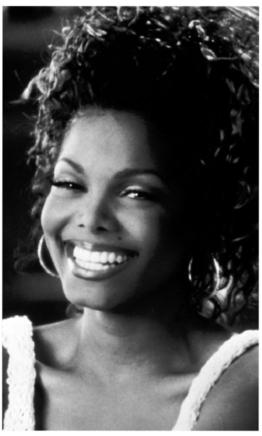Jacko, His Rise and Fall: The Social and Sexual History of Michael Jackson (49 page)
Read Jacko, His Rise and Fall: The Social and Sexual History of Michael Jackson Online
Authors: Darwin Porter

At the time of his meeting with Michael, the director was teaching film at
UCLA. Dmytryk would later recall several meetings with Michael at his
Neverland ranch. "He had dolls everywhere-perhaps he never had a chance
to be a kid himself. Little dolls, big dolls, life-size dolls, and lots of cuddly
teddy bears. I met Jordie Chandler there, the same kid who would later bring
a lawsuit against Michael. A nice kid and rather bright. Perhaps fourteen at the
time. I didn't see anything sexual going on between them, but it might be possible."
Knowing that Dmytryk was a sophisticated man of the world, and a discreet one, Michael confided a secret in him. "I once wanted to look like Diana
Ross and a lot of people say I do. But now I want a different look. I'm going
to have my appearance altered to look like Elizabeth as she was when she
appeared with Mickey Rooney in National Velvet in 1945. I've seen the picture fifteen times."
Although it was later denied, Michael did create a "shrine" to Elizabeth at
Neverland. Michael's publicist, Bob Jones, confirmed the existence of the
shrine to Elizabeth. Several visitors saw it before it was locked permanently,
its exhibits ultimately removed and put into storage when the white-heat
friendship between the two legends dimmed somewhat. Within the shrine, on
giant video screens, Elizabeth's films such as A Place in the Sun, Cleopatra,
and National Velvet played twenty-four hours a day. Michael refused to show
Butterfield 8, the 1960 film in which Elizabeth won an Oscar for her portrayal of a prostitute. "It's okay with me," Elizabeth was quoted as saying. "I
thought the picture was lousy too and didn't want to make it."
Michael designed the wallpaper himself. It portrayed a series of little
heads of Elizabeth. For the walls not covered with paper, Michael demanded
that the painters come up with the exact violet of Elizabeth's eyes, but they
never were able to match the exact shade.
Elizabeth interested Michael in the cause of fighting AIDS, and he not
only donated money for her charity but was her escort to functions in Los
Angeles staged to raise money in the battle against a disease that was killing
off many of her friends. It claimed Rock Hudson, her costar in Giant, on
October 2, 1985.
Michael boycotted the 12th Annual American Music Awards ceremony.
He sensed what was to come. Unlike his great success in 1985 with Thriller,
he failed to win any of the awards for which he was nominated.
Many of the artists who attended the awards ceremony later showed up at
midnight to meet Michael and to record "We Are the World."
Quincy Jones posted a sign outside the studio that read: LEAVE YOUR
EGO AT THE DOOR. The artists came from the worlds of pop, R&B, country, whatever. Among those who appeared were Harry Belafonte, Ray Charles,
Bob Dylan, Cyndi Lauper, Tina Turner, Bette Midler, Willie Nelson, The
Pointer Sisters, Paul Simon, Stevie Wonder, Smokey Robinson, Dionne
Warwick, Bruce Springsteen, and Diana Ross, who went around asking for
autographs. "How could she embarrass me like this?" Michael asked. "She's
too big a star to ask for autographs."
Leaving the studio after a long night, Michael confided that he hadn't had
dinner. He was going home to demand that his chef prepare him a plate of
steamed okra.
One critic of the video claimed that all the stars except Michael had,
indeed, left their egos at the door that night. He demanded that his solo recording be taped privately and away from the rest of the stars. "He wanted to be
different and set aside from the other celebrities," said one of the recording
staff. "Like he was special, better than the rest of the singers. In the video, a
shot begins at his sequined socks and his Bass Weejun shoes. He's so big he
doesn't need to show his face right away."
Michael was overheard bragging, "Fans will know me the moment they
see my socks. Try to photograph Bruce Springsteen's socks. No one will know
who he is. No one!"
"We Are the World-The Video Event" became the ninth best-selling video cassette of 1985, and "We Are the World" as a single record became the
first ever to go multi-platinum, staying number one on Billboard's charts for
a month. The song's sales raised more than $40 million. At the Grammy
Awards at the Shrine Auditorium in Los Angeles in February of 1986, "We
Are the World" won four awards.

Quincy Jones, Lionel Richie, and Michael Jackson, 1985
In June of that year Michael celebrated his success with "We Are the
World" by undergoing yet a fourth operation on his nose, demanding to have
it made even slimmer, although it was quite thin as it was. He claimed that he
would soon turn twenty-eight, and he wanted to celebrate with a thinner nose,
even though Jehovah's Witnesses aren't supposed to observe birthdays.
After he'd recovered from the operation, Michael told friends, "I can
hardly rehearse my music any more. I spend all day looking at my reflection
in the mirror. Dr. Steven Hoefflin is a wonderful plastic surgeon. Because of
me, he's called `The Plastic Surgeon to the Stars.' Not just movie stars go to
him. Even Ivana Trump uses him."
Michael also reminded anyone interested, even Paul Anka, who clearly
wasn't, that "lots of famous stars in the past had nose jobs, even Elvis Presley.
Marilyn Monroe not only had her nose done, but her breasts. You don't think
for a moment that those breasts were actually hers, do you?"
At one point, Frank DiLeo wondered why his client bothered with such
expensive nose jobs and then went out in public with a surgical mask. "The
last time he was spotted, or so I heard, he was wearing a gorilla head mask
with fur. King Kong all the way."
On May 12, 1986, it was announced at a press conference in New York
that Michael's new look would be showcased in Pepsi commercials. Michael,
according to a contract negotiated with the soft drink king, Roger Enrico,
would be paid a record-breaking $15 million. This time he wouldn't have to
split the millions with his brothers, and, according to his demands, would not
have to be seen "drinking one drop of the vile soda." Pepsi also agreed to
sponsor Michael's first nationwide solo
tour, although no dates were announced
for that momentous event. Under most
endorsement deals, an artist is usually
paid in installments. Michael demanded
the entire $15 million up front.

MJ and Bob Jones
When the mega-check cleared,
Michael was not in a mood for celebration. No longer was he thinking of the
competition from Prince, but a challenge
coming from "down the hall," a reference
to the Encino manse where he still lived on the same floor as his younger sister Janet. Family members had overheard
the second-most talented member of the Jackson clan claiming that her new
album, Control, was going to sell more copies than the record-busting
Thriller.
Even Papa Joe had told her, "You'll be as big as Michael-not bigger, but
as big." Janet was in the throes of her own management crisis, as she, like
Michael and her other brothers, wanted to break from her father, turning to
others, such as John McClain, a young executive at A&M, for career guidance, much to her father's rage and fury.
After studying the latest photographs of Janet, Michael was enraged. He
stormed out of his bedroom and rushed downstairs to confront Katherine.
"Janet's even stolen my nose and had a plastic surgeon build an exact copy for
herself. Not only that, she sounds like me. She looks like me. She's stealing
my dance steps."
Katherine was hardly reassuring. "You started a trend. Everybody in the
family, even your father, is trying to look like you, with a little help from plastic surgeons. That is, all except Jackie. He's pleased with the face God gave
him."
With Control, Janet showed the world that she was no longer Daddy's
Little Girl. She finally sacked Papa Joe as her manager and teamed with Terry
Lewis and Jimmy ("Jam") Harris, two multi-talented music men, to create the
album. Joe predicted failure, but Control went on to sell eight million copies
and won Grammys for Lewis and Harris. Reportedly, Michael was furious at
the album's success, especially when it spawned such hit singles as "What
Have You Done for Me Lately?"
Michael complained bitterly to his publicist, Norman Winter, that both La
Toya and Janet were altering their faces to look more like him. "You've got to
do something about it," Michael demanded of Winter.
"But I'm not a plastic surgeon," he protested. "Otherwise, I would make
La Toya look like a female Little Richard and Janet Mike Tyson in drag."
Michael was not amused at Winter's sarcasm. "The way it is now, La Toya
is often mistaken for me when she goes through airports or lounges of deluxe
hotels. Why would anyone mistake La Toya for me? Do you think I look like
a girl?"
Winter had no comment.
Michael's fury spilled over onto Diana Ross when he learned that she was
marrying a white man, Arne Naess, the Norwegian shipping millionaire who
lived in Oslo. At first there had been rumors that he'd attend their wedding the
following February, even functioning as best man for Naess. But later, he sent
word to Ross that he was turning down her invitation to the wedding-"and
future invitations as well."
Ross suffered public humiliation. "He has
Elizabeth Taylor now," she told friends. "What
does he need with the woman who was
responsible for launching his career. Fuck
him! Instead of ordering his chauffeur to call
him Miss Ross, he's probably demanding to be
called Miss Taylor now."
When Elizabeth heard what Ross had said,
she replied, "Meow!"

Janet
Ross got her revenge two years later when
Michael broke his stonewall silence and
requested her appearance on a Showtime special for television. It was to be a tribute from
"loving friends" to Michael's career and life.
Ross cabled that she could not make the commitment because of her busy schedule.
"What do I need her for?" Michael ranted.
"I've got Elizabeth Taylor. Sophia Loren. Gene
Kelly. And Quincy Jones and Sean Lennon, and anybody else I could get if I
really wanted them. She turns me down and I'm a bigger star than Greta
Garbo in her heyday!" He had been reading books about the reclusive Garbo.
At one point, Michael told Winter that he would "henceforth and forever
more" associate only with celebrities who were his equal. He didn't want
minor celebrities being photographed with him "and trying to get a big break
by feeding off my fame."
He made some exceptions to that. Bodyguards at Hayvenhurst would later
report a parade of young boys, ranging in age from nine to fourteen, being
slipped into Michael's bedroom at night. In spite of this clandestine activity,
Michael was still living with his parents at Encino. One guard estimated that
over a three-year period "at least three dozen young kids were slipped in." He
could not offer an explanation about why parents would allow their offspring
to spend the night with an entertainer "approaching the big 3-0" in age.
One guard would later testify that all the boys were white and often
blond and blue-eyed. None of them was black, as was the case with Emmanuel
Lewis. Sometimes these boys would stay in Michael's bedroom for almost a
month. Other boys were sent packing after only a one-night "sleepover."
